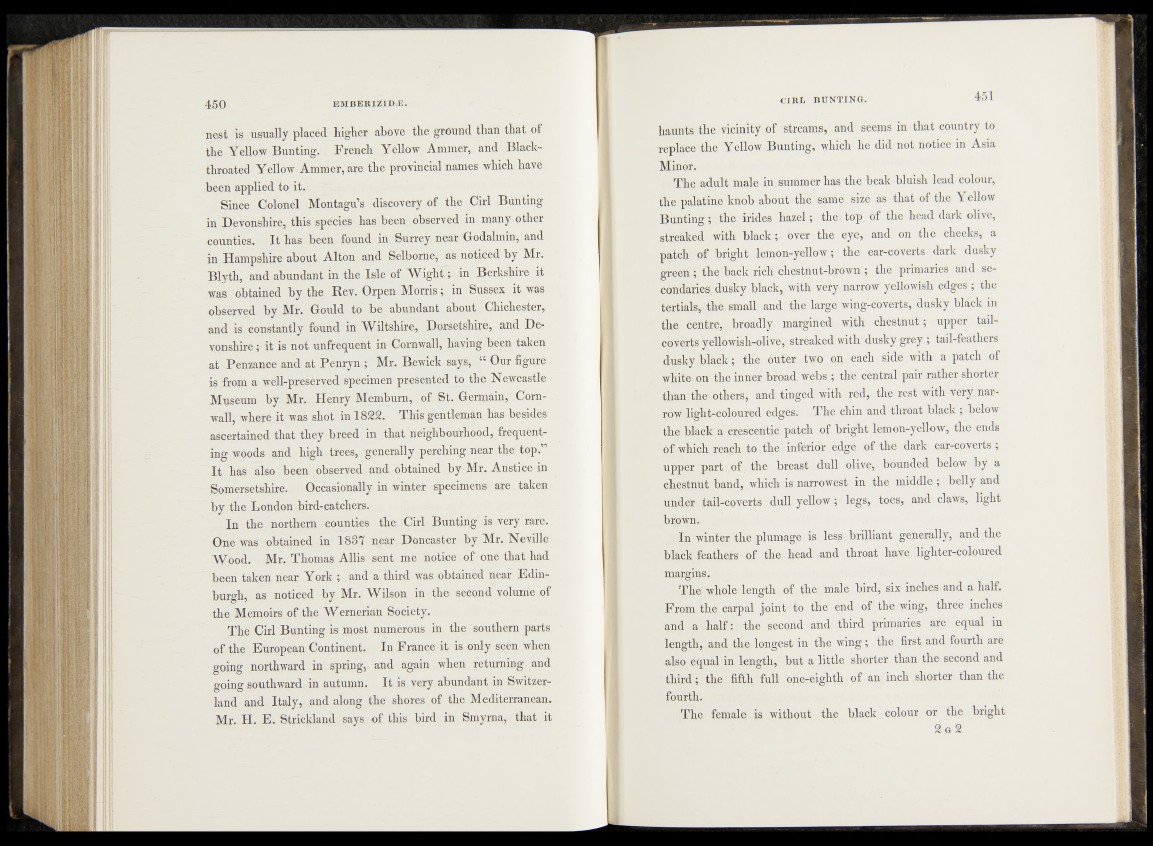
nest is usually placed higher above the ground than that of
the Yellow Bunting. French Yellow A miner, and Black-
throated Yellow Ammer, are the provincial names which have
been applied to it.
Since Colonel Montagu’s discovery of the Cirl Bunting
in Devonshire, this species has been observed in many other
counties. It has been found in Surrey near Godalmin, and
in Hampshire about Alton and Selborne, as noticed by Mr.
Blyth, and abundant in the Isle of W ig h t; in Berkshire it
was obtained by the Rev. Orpen Morris; in Sussex it was
observed by Mr. Could to be abundant about Chichester,
and is constantly found in Wiltshire, Dorsetshire, and Devonshire
; it is not unfrequent in Cornwall, having been taken
at Penzance and at Penryn ; Mr. Bewick says, “ Our figure
is from a well-preserved specimen presented to the Newcastle
Museum by Mr. Henry Memburn, of St. Germain, Cornwall,
where it was shot in 1822. This gentleman has besides
ascertained that they breed in that neighbourhood, frequenting
woods and high trees, generally perching near the top.”
It has also been observed and obtained by Mr. Anstice in
Somersetshire. Occasionally in winter specimens are taken
by the London bird-catchers.
In the northern counties the Cirl Bunting is very rare.
One was obtained in 1887 near Doncaster by Mr. Neville
Wood. Mr. Thomas Allis sent me notice of one that had
been taken near York ; and a third was obtained near Edinburgh,
as noticed by Mr. Wilson in the second volume of
the Memoirs of the Wernerian Society.
The Cirl Bunting is most numerous in the southern parts
of the European Continent. In France it is only seen when
going northward in spring, and again when returning and
going southward in autumn. It is very abundant in Switzerland
and Italy, and along the shores of the Mediterranean.
Mr. H. E. Strickland says of this bird in Smyrna, that it
haunts the vicinity of streams, and seems in that country to
replace the Yellow Bunting, which he did not notice in Asia
Minor.
The adult male in summer has the beak bluish lead colour,
the palatine knob about the same size as that of the Yellow
Bunting; the irides hazel; the top of the head dark olive,
streaked with black; over the eye, and on the cheeks, a
patch of bright lemon-yellow; the ear-coverts dark dusky
green ; the back rich chestnut-brown ; the primaries and secondaries
dusky black, with very narrow yellowish edges ; the
tertials, the small and the large wing-coverts, dusky black in
the centre, broadly margined with chestnut; upper tail-
coverts yellowish-olive, streaked with dusky grey ; tail-feathers
dusky black; the outer two on each side with a patch of
white on the inner broad webs ; the central pair rather shorter
than the others, and tinged with red, the rest with very narrow
light-coloured edges. The chin and throat black ; below
the black a crescentic patch of bright lemon-yellow, the ends
of which reach to the inferior edge of the dark ear-coverts ,
upper part of the breast dull olive, bounded below by a
chestnut band, which is narrowest in the middle ; belly and
under tail-coverts dull yellow; legs, toes, and claws, light
brown.
In winter the plumage is less brilliant generally, and the
black feathers of the head and throat have lighter-coloured
margins.
The whole length of the male bird, six inches and a half.
From the carpal joint to the end of the wing, three inches
and a h a lf: the second and third primaries are equal in
length, and the longest in the wing; the first and fourth are
also equal in length, but a little shorter than the second and
third; the fifth full one-eighth of an inch shorter than the
fourth.
The female is without the black colour or the bright
2 g 2